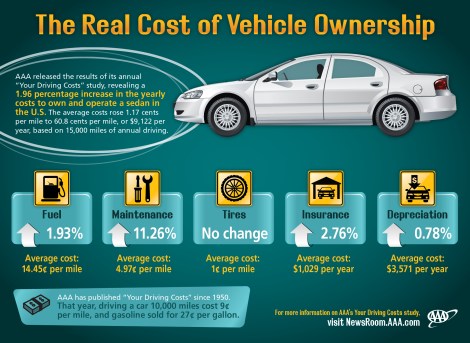The idea is seductively simple: Most of us use our cars just a tiny fraction of the time. Why not make a little money by renting out the neglected speed racer, rather than just leaving it sitting in the driveway, or worse, racking up bills in a parking garage?
“Rent your car, get paid.” That’s how one car-sharing company, RelayRides, puts it on its website. “Earn up to $1,000 a month sharing your vehicle.” Steve Webb, RelayRides’ press guy, tells stories about car owners who have given up their day jobs to become “micro-fleet managers.”
You might be tempted to think like Erinn Hutkin, a Chicago journalist who was laid off from her job at a suburban newspaper in January. She saw an ad from RelayRides while looking for work online and thought, “Here’s a way to make some extra money by not doing much of anything.”
But if all this sounds a little too much like one of those “make $100,000 a year working at home” schemes, surprise: You are right to be a little skeptical.
If my personal experience, interviews with a half-dozen RelayRides car owners, and a look over the national RelayRides listings are any indication, the vast majority of car sharers are not making any money. In fact, with the exception of a few owners who do high-volume business, and folks who rent out high-end cars for big bucks, I’d guess car-sharing is a losing proposition for almost all of them.
David Iverson, a Chicago investment salesman, says he averages $500 a month renting his 2008 Nissan Xterra. His phone rings off the hook with prospective renters, he says, but the expenses rack up, too. He just got slapped with a $786 bill for new brake pads and other routine maintenance, and soon he’ll need to shell out for new tires, too.
“When you factor in parking, insurance, and wear-and-tear, I’m probably breaking even,” Iverson admits. But he’s cool with it. “I like to think I’m doing this in a more altruistic sense, for a community.”
Nothing wrong with that. As most of the people I spoke to for this article said, car-sharing just seems like “the right thing to do.” Share your car, and a handful of your neighbors might be able to get by without one, meaning fewer cars clogging the highways and parking spots.
But if your aim is making money — or if you just want to do a little good for the world without driving yourself directly into bankruptcy — there are a few things you might want to keep in mind. Here are a few suggestions from folks who’ve played the game, and learned some lessons the hard way:
1. Run the numbers
Don’t think that when you’ve shared your car, it’s just out there racking up the profits — because it’s also out there wearing out. Rent it enough, and the oil will need to be changed, the brakes and tires will need to be replaced, and every once in a while, something big will need to be fixed. (Trust me. I speak from experience.)
The American Automobile Association estimates that it costs $9,122 to own and operate the average sedan for a year. Some of these expenses, like insurance, you’ll incur regardless of whether you share your car or not, and that figure includes the cost of gas, which renters cover when they use your car. But most costs, including maintenance, tires, and depreciation (that is, the decline in resale value), go up the more your car is driven. Here’s the breakdown from the AAA’s 2013 driving costs report:
To get a sense of how much it costs to own and operate your car, check out the AAA’s “Your Driving Costs 2013” brochure [PDF].
2. Factor in your time
One of the biggest costs of car-sharing doesn’t show up in the cost-of-owning-a-car reports, and that’s the hours you’ll spend setting up rentals, vetting prospective renters, and keeping the car in ship shape. While short-term rentals bring in more per hour, several RelayRides owners I spoke with told me they like the longer-term rentals better. “From a dollar-and-cents and practical perspective, longer rentals are so much better for me,” Iverson told me. Getting a car cleaned and checked out in between multiple hourly rentals is just too much hassle — and if one renter returns a car late, which is not uncommon, the next person in line is apt to be miffed.
Bear in mind, too, that you’ll be working on other people’s schedules, which often means fielding rental requests and handing off keys when you’re supposed to be working at your day job. That may not be a problem if, like Iverson, you work for yourself, from home. But Mary Blair Conor, of Seattle, learned this the hard way. Her husband, Jeff, talked her into renting their 2006 Scion xA, only to discover that most people wanted to do business while he was at the office, miles from home.
“Once we realized most people didn’t want to rent a car at night, I started handling the renting,” Blair Conor says. “He’s just not available to actually do any of it.”
A “mobile access” kit can help with this, allowing renters to get into the car using a smartphone. Ezeibe Anosike, a business student at the University of Chicago who rents out his 2007 Volkswagen GTI, has an arrangement with the valets at his parking garage, who check renters’ licenses and give them access to the vehicle. But many owners like to hand off the keys in person, to eyeball their renters and let them know that there’s a human behind this car, not just a corporation.
And maintenance and repairs take time, too. Everyone I spoke to said RelayRides was good about covering the cost of repairs for damages incurred during rentals, but even if the company’s insurance policy covers the expense, you may still need to get multiple estimates — and your car may be out of commission for weeks while repairs are made.
3. Set appropriate prices
Given what you now know about the costs of owning this gas guzzler and keeping it clean, tuned, insured, and ready to rent, you now have some basis for setting your prices. If my experience is any indication, the prices that RelayRides suggests may be far below what you’ll need to cover your costs. My advice to you would be to spend more time looking at what local rental agencies and “carshare” companies like Zipcar charge, and less time looking at other cars for rent on RelayRides or other “peer-to-peer” platforms. (Note, too, that the big guys change their prices with the seasons, as demand rises and falls.)
You also have a couple of tools that allow you to limit the number of miles renters put on your car. The first is to simply jack up the rates for longer-term rentals. “If they’re taking it for a week, that means that they’re driving from here to Nevada and back,” says Paul Supawanich, a San Francisco transportation planner who has rented out his 2008 Subaru Outback almost 300 times. “We tried to price it such that more people would use it for around-town trips.”
RelayRides also allows you to set a daily limit on mileage and charge renters by the mile when they go over the limit. But that doesn’t stop renters from overshooting, and the company keeps almost a third of the penalty charges.
4. Be picky about who you rent to
RelayRides checks would-be renters’ driving records, ruling out anyone with a major driving violation or more than a set number of minor violations. “It’s not like Craiglist where you’re just praying to god that the person is who he says he is,” Blair Conor says. But some people are more trustworthy than others — and even if they’re not trashing your car, returning it late can throw a wrench into the works if you’re trying to run a business — or, you know, get someplace you need to go.
Car-sharing attracts younger renters who don’t qualify to rent from the big agencies, many of which refuse to rent to anyone under 25. “I pay clear attention to renters,” Anosike says. “I look at their ratings and comments people leave, and I discriminate.”
Got a prospective renter who hasn’t built up a reputation on the car-sharing platform you’re using? Sometimes they have reputations elsewhere. I was able to check out one renter via Airbnb, where she had a whole pile of positive comments and reviews.
Play your cards right, and eventually you won’t have to rent to total strangers: “We’ve been renting for two years now,” Supawanich says. “In that time, we’ve developed a solid group of regulars who I would have no hesitation renting my car to.”
5. Err on the side of oversharing
A number of people told me that the best thing you can do for your car-sharing business is to be super clear about your expectations and your rules. “I’ve tried to be overly communicative,” Supawanich says. “That way whoever is renting knows that I’m paying attention.”
He also sends a clear message to renters by keeping his car well-maintained and clean. They see that, Supawanich says, and “they get some sense that the owner cares about that car.”
All of that communicating also tells you something about the person who wants to rent your vehicle, says Blair Conor: “One hundred percent of the time, if they’re flaky about communication, they’ll be flaky when they rent.”
6. If something goes wrong, deal with it right away
RelayRides boasts a $1 million insurance policy on all cars that are rented through its website, but the policy only covers damages that are reported within 24 hours. And even the smallest car parts can cost a pretty penny. Blair Conor says one renter accidentally pulled off the knob that allows her back seat to fold down. Her husband thought he could fix it, but let it slide, and now it looks like the whole mechanism may need to be replaced.
After a bad experience with a renter who damaged his car and denied it, Anosike has started using a vehicle inspection form, asking renters to check the car for damage before they drive away — just like a car rental agency.
7. Brace yourself for heartbreak
My last bit of advice? Prepare yourself emotionally to watch the love buggy ride off into the sunset with someone else at the wheel. It’s a big, cruel world out there. Shit happens, even to the best of drivers. “I love my car but I’ve had to learn to distance my emotions,” Anosike says.
More on that in the next post …
This is part 3 in an occasional series about car-sharing. Read part 1 here, and part 2 here.




